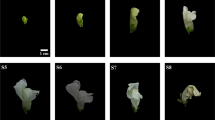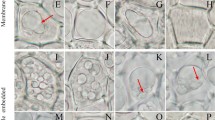Abstract
Key message
An increase in Ca 2+ concentration in the nucleus may activate the PCD of secretory cavity cells, and further Ca 2+ accumulation contributes to the regulation of nuclear DNA degradation.
Abstract
Calcium plays an important role in plant programmed cell death (PCD). Previously, we confirmed that PCD was involved in the degradation of secretory cavity cells in Citrus sinensis (L.) Osbeck fruits. To further explore the function of calcium in the PCD of secretory cavity cells, we used potassium pyroantimonate precipitation to detect and locate calcium dynamics. At the precursor cell stage of the secretory cavity, Ca2+ was only distributed in the cell walls. At the early stage of secretory cavity initial cells, Ca2+ in the cell walls was gradually transported into the cytoplasm via pinocytotic vesicles. Although a small amount of Ca2+ was present in the nucleus, the TUNEL signal was scarcely observed. At the middle stage of initial cells, a large number of pinocytotic vesicles were transferred to the nucleus, where the vesicle membrane fused with the nuclear membrane to release calcium into the nucleoplasm. In addition, abundant Ca2+ aggregated in the condensed chromatin and nucleolus, where the TUNEL signal appeared the strongest. At the late stage of initial cells, the chromatin and nucleolus gradually degraded and disappeared, and the nucleus appeared broken-like, as Ca2+ in the cell wall had nearly completely disappeared, and Ca2+ in the nucleus was also rapidly reduced. Furthermore, the TUNEL signal also disappeared. These phenomena indicated that an increase in Ca2+ concentration in the nucleus might activate the PCD of secretory cavity cells, and further Ca2+ accumulation contributed to the regulation of nuclear DNA degradation.




Similar content being viewed by others
References
Aleksandrushkina NI, Vanyushin BF (2009) Endonucleases and their involvement in plant apoptosis. Russ J Plant Physiol 56:291–305
Azad AK, Ishikawa Takayuki, Ishikawa Takahiro, Sawa Y, Shibata H (2008) Intracellular energy depletion triggers programmed cell death during petal senescence in tulip. J Exp Bot 59:2085–2095
Bosch M, Franklin-Tong VE (2008) Self-incompatibility in Papaver: signalling to trigger PCD in incompatible pollen. J Exp Bot 59:481–490
Cao J, Jiang F, Sodmergen Cui KM (2003) Time-course of programmed cell death during leaf senescence in Eucommia ulmoides. J Plant Res 116:7–12
Chen Y, Wu H (2010) Programmed cell death involved in the schizolysigenous formation of the secretory cavity in Citrus sinensis L. (Osbeck). Chin Sci Bull 55:2160–2168
Chen HM, Pang Y, Zeng J, Ding Q, Yin SY, Liu C, Lu MZ, Cui KM, He XQ (2012) The Ca2+-dependent DNases are involved in secondary xylem development in Eucommia ulmoides. J Integr Plant Biol 54:456–470
Dayod M, Tyerman SD, Leigh RA, Gilliham M (2010) Calcium storage in plants and the implications for calcium biofortification. Protoplasma 247:215–231
Domínguez F, Cejudo FJ (2006) Identification of a nuclear-localized nuclease from wheat cells undergoing programmed cell death that is able to trigger DNA fragmentation and apoptotic morphology on nuclei from human cells. Biochem J 397:529–536
Domínguez F, Moreno J, Cejudo FJ (2004) A gibberellin-induced nuclease is localized in the nucleus of wheat aleurone cells undergoing programmed cell death. J Biol Chem 279:11530–11536
Fang M, Zhang HQ, Xue SB, Li N, Wang LM (1998) Intracellular calcium distribution in apoptosis of HL-60 cells induced by harringtonine: intranuclear accumulation and regionalization. Cancer Lett 127:113–121
Hao YJ, Wang DH, Peng YB, Bai SL, Xu LY, Li YQ, Xu ZH, Bai SN (2003) DNA damage in the early primordial anther is closely correlated with stamen arrest in the female flower of cucumber (Cucumis sativus L.). Planta 217:888–895
He X, Kermode AR (2003) Nuclease activities and DNA fragmentation during programmed cell death of megagametophyte cells of white spruce (Picea glauca) seeds. Plant Mol Biol 51:509–521
Ito J, Fukuda H (2002) ZEN1 is a key enzyme in the degradation of nuclear DNA during programmed cell death of tracheary elements. Plant Cell 14:3201–3211
Jones A (2000) Dose the plant mitochondrion integrate cellular stress and regulate programmed cell death. Trends Plant Sci 5:225–230
Lachaud C, Da Silva D, Cotelle V, Thuleau P, Xiong TC, Jauneau A, Briere C, Graziana A, Bellec Y, Faure J, Ranjeva R, Mazars C (2010) Nuclear calcium controls the apoptotic-like cell death induced by d-erythro-sphinganine in tobacco cells. Cell Calcium 47:92–100
Lachaud C, Silva DD, Amelot N, Béziat C, Brière C, Cotelle V, Graziana A, Grat S, Mazars C, Thuleau P (2011) Dihydrosphingosine-induced programmed cell death in tobacco BY-2 cells is independent of H2O2 production. Mol Plant 4:310–318
Lin JS, Wang Y, Wang GX (2005) Salt stress-induced programmed cell death via Ca2+-mediated mitochondrial permeability transition in tobacco protoplasts. Plant Growth Regul 45:243–250
Liu PW, Liang SJ, Yao N, Wu H (2012) Programmed cell death of secretory cavity cells in fruits of Citrus grandis cv. Tomentosa is associated with activation of caspase 3-like protease. Trees Struct Funct 26:1821–1835
Mazars C, Thuleau P, Lamotte O, Bourque S (2010) Cross-talk between ROS and calcium in regulation of nuclear activities. Mol Plant 3:706–718
Mittler R, Lam E (1995) Identification, characterization, and purification of a tobacco endonuclease activity induced upon hypersensitive response cell death. Plant Cell 7:1951–1962
Mittler R, Simon L, Lam E (1997) Pathogen-induced programmed cell death in tobacco. J Cell Sci 110:1333–1344
Qiu YL, Liu RS, Xie CT, Russell SD, Tian HQ (2008) Calcium changes during megasporogenesis and megaspore degeneration in lettuce (Lactuca sativa L.). Sex Plant Reprod 21:197–204
Tian HQ, Kuang A, Musgrave ME, Russell SD (1998) Calcium distribution in fertile and sterile anthers of a photoperiod-sensitive genic male-sterile rice. Planta 204:183–192
Wang XP, Su LX, Su JW (2006) Distribution changes of calcium and programmed cell death in the pistil of litchi (Litchi chinensis Sonn.) flower during its development. Mol Plant 32:607–616
Wang Y, Lin JS, Wang GX (2010) Role of calcium in nitric oxide-induced programmed cell death in tobacco protoplasts. Biol Planta 54:471–476
White PJ, Broadley MR (2003) Calcium in plants. Ann Bot 92:487–511
Wood M, Power JB, Davey MR, Lowe KC, Mulligan BJ (1998) Factors affecting single strand-preferring nuclease activity during leaf aging and dark-induced senescence in barley (Hordeum vulgare L.). Plant Sci 131:149–159
Xu Y, Hanson MR (2000) Programmed cell death during pollination-induced petal senescence in petunia. Plant Physiol 122:1323–1334
Yao N, Tada Y, Park P, Nakayashiki H, Tosa Y, Mayama S (2001) Novel evidence for apoptotic cell response and differential signals in chromatin condensation and DNA cleavage in victorin-treated oats. Plant J 28:13–26
Young TE, Gallie DR, DeMason DA (1997) Ethylene-mediated programmed cell death during maize endosperm development of wild-type and shrunken2 genotypes. Plant Physiol 115:737–751
Zhang M, Zhang HQ, Xue SB (2000) Effect of Bcl-2 and caspase-3 on calcium distribution in apoptosis of HL-60 cell. Cell Res 10:213–220
Zuppini A, Navazio L, Sella L, Castiglioni C, Favaron F, Mariani P (2005) An endopolygalacturonase from Sclerotinia sclerotiorum induces calcium-mediated signaling and programmed cell death in soybean cells. Mol Plant Microbe Interact 18:849–855
Author contribution statement
Zheng Ping and Bai Mei are responsible for catology and cytochemistry experiments and related results analysis. Chen Ying and Liang Shejian are responsible for PCD detection. Liu Peiwei and Gao Lu are responsible for the preliminary experiments about calcium localization. Wu Hong is responsible for the results and essay writing.
Acknowledgments
This work was supported by the National Natural Science Foundation of China (Project No. 30670119) to HW.
Conflict of interest
The authors declare that they have no conflict of interest.
Author information
Authors and Affiliations
Corresponding author
Additional information
Communicated by D. Treutter.
P. Zheng and M. Bai are co-first authors.
Rights and permissions
About this article
Cite this article
Zheng, P., Bai, M., Chen, Y. et al. Programmed cell death of secretory cavity cells of citrus fruits is associated with Ca2+ accumulation in the nucleus. Trees 28, 1137–1144 (2014). https://doi.org/10.1007/s00468-014-1024-z
Received:
Revised:
Accepted:
Published:
Issue Date:
DOI: https://doi.org/10.1007/s00468-014-1024-z




